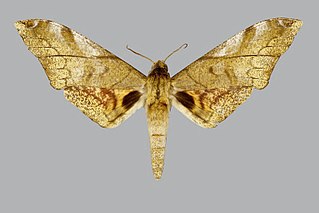
Polyptychus affinis is a moth of the family Sphingidae first described by Walter Rothschild and Karl Jordan in 1903. It is known at elevations up to 6,000 feet (1,800 m) in forests from Sierra Leone to the Congo, Uganda and western Kenya.

Macroglossum milvus is a moth of the family Sphingidae. It is known from Réunion and Mauritius.

Rhadinopasa is a monotypic moth genus in the family Sphingidae erected by Ferdinand Karsch in 1891. Its only species, Rhadinopasa hornimani, was first described by Herbert Druce in 1880. It is known from lowland forest from Gabon, Cameroon and the Central African Republic to the Democratic Republic of the Congo to Uganda and Tanzania.

Euchloron is a monotypic moth genus of the family Sphingidae first described by Jean Baptiste Boisduval in 1875. Its only species, Euchloron megaera, the verdant hawk, is known from most of Africa and Yemen. It is a migratory species.

Charaxes castor, the giant emperor or giant charaxes, is a butterfly of the family Nymphalidae. It is found throughout the Afrotropical realm below the Sahel.

Bridelia micrantha, the mitzeeri or the coastal golden-leaf, is a tree in the family Phyllanthaceae and is native to tropical and southern Africa as well as to the island of Réunion in the Indian Ocean.

Platysphinx constrigilis is a moth of the family Sphingidae first described by Francis Walker in 1869. It is known from Africa.

Basiothia medea, the small verdant hawk, is a moth of the family Sphingidae. It is common in open habitats throughout the Ethiopian Region, including Madagascar. It is however probably absent from the equatorial forest belt, except as a vagrant. The species is an active migrant.

Polyptychoides grayii, or Gray's polyptychus, is a moth of the family Sphingidae. It is known from eastern Africa, south to South Africa.

Pseudoclanis occidentalis is a moth of the family Sphingidae. It is known from Sierra Leone, Ivory Coast, Ghana, Cameroon, Gabon, the Central African Republic and Kenya.

Falcatula falcatus is a moth of the family Sphingidae. It is known from savanna and woodland from Zimbabwe to Malawi, Mozambique, Zambia, the Central African Republic and eastern Africa.

Batocnema coquerelii is a moth of the family Sphingidae. It is known from Madagascar, the Aldabra Islands and the Comoro Islands.

Lophostethus dumolinii is a moth of the family Sphingidae. It is known from most habitats, except desert and high mountains throughout the Ethiopian Region, excluding Madagascar and the Cape in South Africa.

Dovania poecila is a moth of the family Sphingidae. It is known from forests in Kenya, Uganda, Rwanda, Burundi, Tanzania and Malawi.

Cephonodes apus is a moth of the family Sphingidae. It is known from the Islands of Réunion and Mauritius.

Temnora zantus is a moth of the family Sphingidae. It is known from forests in Congo and Uganda.

Nephele densoi is a moth of the family Sphingidae. It is known from Madagascar and the Comoro Islands.

Nephele oenopion is a moth of the family Sphingidae. It is known from Africa.

Theretra capensis is a moth of the family Sphingidae. It is known from woodland and open habitats from the Cape to Zimbabwe, Zambia, Democratic Republic of the Congo, Malawi, Mozambique and East Africa.
Diapalpus congregarius is a moth species of the family Lasiocampidae. It was first described in 1913 by Embrik Strand and is the type species of genus Diapalpus. It is found in the Democratic Republic of the Congo and Tanzania.


















